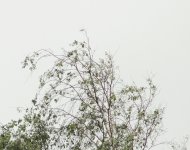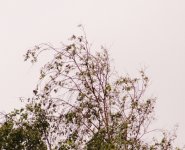looksharp65
Well-known member

Hi guys, today rained all day so I took a day off birding to write down some thoughts about my three currently most used binoculars.
No great secrets are actually revealed since one of them is discontinued many years ago, another recently discontinued and the last stands in the line, too.
Sorry about that, but it was what I could afford 3
This simple comparison suffers from a number of inherent error sources. The most apparent among them is that the Vortex binocular has a radically different magnification than the other two.
This will earn it some extra points in the Spectacle friendliness and Ergonomics moments.
To avoid erroneous interpretation of their brightness, they were stopped down to 21 mm, yielding an exit pupil of 3.23 mm.
Ranking problems
I often found the differences too small to discern, then I gave two binoculars the same points.
On other occasions, the numbers may suggest that there are larger differences than there really is.
An exception would be the contrast, where the Nikon's contrast is way above the other two and where I'd have liked to give it a 4 or a 5, thus abandoning the ranking method for a points method.
Selection of properties used for ranking
Another objection that can be made against this ranking contest is that some properties are excluded. Value for money, warranties and some individual properties that are judged as a whole can be argued.
As an example, I have excluded image distortion from the test since I'm not particularly susceptible to it.
None of these bins have ever caused me eye strain or nausea, nor have they shown objectionable distortion in field use.
Below follows explanations and a plethora of added details regarding the various parts of the contest.
Image sharpness – edge.
All three samples exceed my visual acuity at the center, although the Zeiss is clearly the sharpest when resolution is boosted. The Nikon, being considerably sharper than its contenders outside the center and all the way to the edge, is the clear winner.
But how to judge the other two when they have different magnification and very different AFOV? If they had similar sweet spot percentage, the Zeiss with its massive 69 degree AFOV would win over the 55 degree Fury, but in sweet spot as an exact number of degrees, the Fury would win. Dead heat I guess.
Low light performance
After stopping down the Fury, the Zeiss FL is king here. Despite the twilight factor impact, the Nikon wasn't quite able to match the Fury looking into deep shade in dusk.
This may be the downside of its high contrast. But once there is just a little more light, it lifts out brighter details against a seducingly black background.
Straylight
The Nikon and the Vortex are very close here. Neither of them loses contrast facing the Sun, but the Nikon's high contrast is there all the way which makes the view through them a lot more contrasty than without them. A truly outstanding result!
The Zeiss' amazing brightness takes another jump up when pointing them towards the general direction of the Sun. Unfortunately this is straylight and the brightness increases at the expense of contrast loss. Shading them with the hand regains the contrast.
Considering that these binoculars are very short, have a massive FOV and don't produce any ghost images or gray crescents, the result is still quite good though not at alpha level.
Ghost images
I have abstained from giving points here since none of them produce reflections or ghost images to an objectionable degree.
Image color
The Fury is the clear winner with a mostly imperceptible and always occasional warm hint.
Their color rendition is in other words very, very neutral.
Ranking the two alphas was quite difficult. As has been described before, the FL is so bright that the colors seem washed-out and sometimes downright dull. Furthermore, the color rendition is not neutral but leans towards the blue/green side, though much less than the Nikon leans towards the orangey side.
The latter could serve as an example of ”augmented reality” since it seemingly makes all colors very saturated, except possibly for the blue. Especially different nuances of brown stand out and (sort of) gives the brown birds a luscious ”make up”.
Contrast
The brightness of the Zeiss makes some details more readily visible, though this is not high contrast. On the contrary, their brightness seems to reduce contrast and color saturation.
They always seem at least as bright as the naked eye as long as there are traces of daylight left.
The Nikons often give me an impression of being slightly darker than the naked eye, but their incredible contrast make everything I look at ”POP” out from the image.
I have found myself preferring these for use in bright sunlight since they seem to cut through the haze like no other binoculars I have tried. But on overcast days they seem to improve the colors.
The Fury's contrast seems the most natural, just like their color rendition.
Chromatic aberration
Of course the FL is the clear winner, displaying a minimum of CA in virtually any situation.
The Nikon's CA can be excessive at times, but for the most it doesn't make much noise. Comparing it to the Fury is not easy because of the difference in magnification, and I must admit I have to push myself to find CA in the Fury.
However, if I try to imagine how it would perform if it were a 10x, I'd possibly rate them equal.
Mechanical construction
The Nikon is built like a tank and leads my feelings towards the Nikon Tropical I owned some time ago. One remark could be made about the rubber eyecups that seem a little loose. -I can't see this thing break!
The Zeiss is rugged as well, but the focus knob is a bit rough and gritty. Have some doubts about the diopter too.
The Vortex is quite solid but nowhere near the other two. The eyecups are a bit wobbly and need to be readjusted now and then.
The rubber armor seems thin where the thumbs rest, since I can feel the armor slide against the metal when I push and pull. The focus knob is decidedly better than the Zeiss', though.
Ergonomics
The Fury is the largest of the three, even bigger than the Nikon and fits my large hands like a glove.
Everything is in the right place and works intuitively.
The small Zeiss has surprisingly much space for the thumbs but is too short to hold comfortably with two hands.
The Nikon, finally, leaves me puzzled since I probably hold it in different ways every time I pick it up, and none of them is very comfortable. Then, there's the weight issue where three or four ounces less weight would have been welcome.
Spectacle friendliness
This interacts with the PFOV part. The Fury's massive eye relief allows it to be held 4 mm in front of the spectacle lenses and the whole field is easily visible.
Thus, the eye relief could be named excessive.
The Zeiss' huge AFOV is fully visible with my spectacles, which is quite an achievement.
If I had been hyperopic, I doubt I would have managed to see it all.
The Nikon falls short because of an inappropriate eyecup design where the outer edge is raised to a lip, then inclined inwards against the ocular lens. If it had been squared at the edge, about 1.5 mm of usable eye relief had been gained.
PFOV
The huge AFOV of the Zeiss make up for a great walk-in or PFOV experience. When the eyecups are collapsed on the Fury, they also nearly seem to disappear when held in front of the eyes, but only then!
The Nikons would be better off with other eyecups, and I'll search for others to exchange them in order to see the field stop.
Focus knob
I prefer fast focusers and the Nikon is about as fast as it can get. It is superbly smooth and with perfect friction to avoid overshooting, which otherwise would be easy with such a fast focus.
The Fury's knob goes very easy and is fast as well. The huge depth of field in the 6.5x eliminates the overshooting problem. I doubt I'd like the Fury 10x32 to have such a loose knob.
The Zeiss' knob is reasonably smooth but still somewhat gritty, but it does what it's supposed to.
Diopter
Nikon: Set and forget!
Vortex: Set and set and set and set. It's as easy to lose the setting tucked into a backpack as it is to set it again.
Zeiss: I have to admit I feel uncertain whether my eyes change or the diopter drifts. Adjusting it is more difficult than with the Fury and it is difficult to perform the very minute touches required to get it right. This is not alpha-style, IMHO.
Field of view
The Fury should not participate here, being a 6.5x wide angle bin. But considering the Zeiss is extremely wide for its magnification, the Nikon quite wide and the Fury 6.5x normally wide for its magnification, I decided to give the Nikon and the Fury the same points. After all, the Fury 10x32 has about the same FOV as the Nikon.
Other thoughts
The results were NOT prearranged to reach a dead heat. The fact that the Zeiss FL didn't score higher was in fact a surprise for me, as were the nearly identical final results.
All three are, in their own way, a joy to own and use. With some premeditation, I could pick either of the 10x32s and have the bin that's tailored to match the situation. On the other hand, it is obvious that with a great advantage follows some disadvantage. The Fury, though, seems to be wisely engineered to balance and avoid disadvantages by offering a sober set of advantages. Considering its retail price, I can but repeat that it was a great buy.
My favorite bin? It has the shape, weight and color balance of the Fury, the contrast, straylight control, edge sharpness and mechanics of the Nikon and finally the brightness, CA control and wide FOV of the Zeiss.
And here, I'm pretty sure Dennis will chime in and say that it's the EDG I want.
He might be right, too.
//L
Zeiss FL Vortex Fury Nikon HG
_____________________________________________________________________
Image sharpness – edge 1,5 1,5 3
Low light performance 3 2 1
Stray light 1 2 3
Ghost image - - -
Image color 1,5 3 1,5
Contrast 1 2 3
CA 3 1,5 1,5
Mechanical construction 2 1 3
Ergonomics 2 3 1
Spectacle friendliness 2,5 2,5 1
PFOV 3 2 1
Focus knob 1 2 3
Diopter 1 2 3
Field of view 3 1,5 1,5
_____________________________________________________________________
Total 25,5 26 26,5
Chart easier to read here:
http://www.evernote.com/shard/s199/sh/ef8967bc-b0fc-40eb-91eb-b3c786900c9e/e9234732be463d79ffd3f0ebb6dd6c67
No great secrets are actually revealed since one of them is discontinued many years ago, another recently discontinued and the last stands in the line, too.
Sorry about that, but it was what I could afford 3
This simple comparison suffers from a number of inherent error sources. The most apparent among them is that the Vortex binocular has a radically different magnification than the other two.
This will earn it some extra points in the Spectacle friendliness and Ergonomics moments.
To avoid erroneous interpretation of their brightness, they were stopped down to 21 mm, yielding an exit pupil of 3.23 mm.
Ranking problems
I often found the differences too small to discern, then I gave two binoculars the same points.
On other occasions, the numbers may suggest that there are larger differences than there really is.
An exception would be the contrast, where the Nikon's contrast is way above the other two and where I'd have liked to give it a 4 or a 5, thus abandoning the ranking method for a points method.
Selection of properties used for ranking
Another objection that can be made against this ranking contest is that some properties are excluded. Value for money, warranties and some individual properties that are judged as a whole can be argued.
As an example, I have excluded image distortion from the test since I'm not particularly susceptible to it.
None of these bins have ever caused me eye strain or nausea, nor have they shown objectionable distortion in field use.
Below follows explanations and a plethora of added details regarding the various parts of the contest.
Image sharpness – edge.
All three samples exceed my visual acuity at the center, although the Zeiss is clearly the sharpest when resolution is boosted. The Nikon, being considerably sharper than its contenders outside the center and all the way to the edge, is the clear winner.
But how to judge the other two when they have different magnification and very different AFOV? If they had similar sweet spot percentage, the Zeiss with its massive 69 degree AFOV would win over the 55 degree Fury, but in sweet spot as an exact number of degrees, the Fury would win. Dead heat I guess.
Low light performance
After stopping down the Fury, the Zeiss FL is king here. Despite the twilight factor impact, the Nikon wasn't quite able to match the Fury looking into deep shade in dusk.
This may be the downside of its high contrast. But once there is just a little more light, it lifts out brighter details against a seducingly black background.
Straylight
The Nikon and the Vortex are very close here. Neither of them loses contrast facing the Sun, but the Nikon's high contrast is there all the way which makes the view through them a lot more contrasty than without them. A truly outstanding result!
The Zeiss' amazing brightness takes another jump up when pointing them towards the general direction of the Sun. Unfortunately this is straylight and the brightness increases at the expense of contrast loss. Shading them with the hand regains the contrast.
Considering that these binoculars are very short, have a massive FOV and don't produce any ghost images or gray crescents, the result is still quite good though not at alpha level.
Ghost images
I have abstained from giving points here since none of them produce reflections or ghost images to an objectionable degree.
Image color
The Fury is the clear winner with a mostly imperceptible and always occasional warm hint.
Their color rendition is in other words very, very neutral.
Ranking the two alphas was quite difficult. As has been described before, the FL is so bright that the colors seem washed-out and sometimes downright dull. Furthermore, the color rendition is not neutral but leans towards the blue/green side, though much less than the Nikon leans towards the orangey side.
The latter could serve as an example of ”augmented reality” since it seemingly makes all colors very saturated, except possibly for the blue. Especially different nuances of brown stand out and (sort of) gives the brown birds a luscious ”make up”.
Contrast
The brightness of the Zeiss makes some details more readily visible, though this is not high contrast. On the contrary, their brightness seems to reduce contrast and color saturation.
They always seem at least as bright as the naked eye as long as there are traces of daylight left.
The Nikons often give me an impression of being slightly darker than the naked eye, but their incredible contrast make everything I look at ”POP” out from the image.
I have found myself preferring these for use in bright sunlight since they seem to cut through the haze like no other binoculars I have tried. But on overcast days they seem to improve the colors.
The Fury's contrast seems the most natural, just like their color rendition.
Chromatic aberration
Of course the FL is the clear winner, displaying a minimum of CA in virtually any situation.
The Nikon's CA can be excessive at times, but for the most it doesn't make much noise. Comparing it to the Fury is not easy because of the difference in magnification, and I must admit I have to push myself to find CA in the Fury.
However, if I try to imagine how it would perform if it were a 10x, I'd possibly rate them equal.
Mechanical construction
The Nikon is built like a tank and leads my feelings towards the Nikon Tropical I owned some time ago. One remark could be made about the rubber eyecups that seem a little loose. -I can't see this thing break!
The Zeiss is rugged as well, but the focus knob is a bit rough and gritty. Have some doubts about the diopter too.
The Vortex is quite solid but nowhere near the other two. The eyecups are a bit wobbly and need to be readjusted now and then.
The rubber armor seems thin where the thumbs rest, since I can feel the armor slide against the metal when I push and pull. The focus knob is decidedly better than the Zeiss', though.
Ergonomics
The Fury is the largest of the three, even bigger than the Nikon and fits my large hands like a glove.
Everything is in the right place and works intuitively.
The small Zeiss has surprisingly much space for the thumbs but is too short to hold comfortably with two hands.
The Nikon, finally, leaves me puzzled since I probably hold it in different ways every time I pick it up, and none of them is very comfortable. Then, there's the weight issue where three or four ounces less weight would have been welcome.
Spectacle friendliness
This interacts with the PFOV part. The Fury's massive eye relief allows it to be held 4 mm in front of the spectacle lenses and the whole field is easily visible.
Thus, the eye relief could be named excessive.
The Zeiss' huge AFOV is fully visible with my spectacles, which is quite an achievement.
If I had been hyperopic, I doubt I would have managed to see it all.
The Nikon falls short because of an inappropriate eyecup design where the outer edge is raised to a lip, then inclined inwards against the ocular lens. If it had been squared at the edge, about 1.5 mm of usable eye relief had been gained.
PFOV
The huge AFOV of the Zeiss make up for a great walk-in or PFOV experience. When the eyecups are collapsed on the Fury, they also nearly seem to disappear when held in front of the eyes, but only then!
The Nikons would be better off with other eyecups, and I'll search for others to exchange them in order to see the field stop.
Focus knob
I prefer fast focusers and the Nikon is about as fast as it can get. It is superbly smooth and with perfect friction to avoid overshooting, which otherwise would be easy with such a fast focus.
The Fury's knob goes very easy and is fast as well. The huge depth of field in the 6.5x eliminates the overshooting problem. I doubt I'd like the Fury 10x32 to have such a loose knob.
The Zeiss' knob is reasonably smooth but still somewhat gritty, but it does what it's supposed to.
Diopter
Nikon: Set and forget!
Vortex: Set and set and set and set. It's as easy to lose the setting tucked into a backpack as it is to set it again.
Zeiss: I have to admit I feel uncertain whether my eyes change or the diopter drifts. Adjusting it is more difficult than with the Fury and it is difficult to perform the very minute touches required to get it right. This is not alpha-style, IMHO.
Field of view
The Fury should not participate here, being a 6.5x wide angle bin. But considering the Zeiss is extremely wide for its magnification, the Nikon quite wide and the Fury 6.5x normally wide for its magnification, I decided to give the Nikon and the Fury the same points. After all, the Fury 10x32 has about the same FOV as the Nikon.
Other thoughts
The results were NOT prearranged to reach a dead heat. The fact that the Zeiss FL didn't score higher was in fact a surprise for me, as were the nearly identical final results.
All three are, in their own way, a joy to own and use. With some premeditation, I could pick either of the 10x32s and have the bin that's tailored to match the situation. On the other hand, it is obvious that with a great advantage follows some disadvantage. The Fury, though, seems to be wisely engineered to balance and avoid disadvantages by offering a sober set of advantages. Considering its retail price, I can but repeat that it was a great buy.
My favorite bin? It has the shape, weight and color balance of the Fury, the contrast, straylight control, edge sharpness and mechanics of the Nikon and finally the brightness, CA control and wide FOV of the Zeiss.
And here, I'm pretty sure Dennis will chime in and say that it's the EDG I want.
He might be right, too.
//L
Zeiss FL Vortex Fury Nikon HG
_____________________________________________________________________
Image sharpness – edge 1,5 1,5 3
Low light performance 3 2 1
Stray light 1 2 3
Ghost image - - -
Image color 1,5 3 1,5
Contrast 1 2 3
CA 3 1,5 1,5
Mechanical construction 2 1 3
Ergonomics 2 3 1
Spectacle friendliness 2,5 2,5 1
PFOV 3 2 1
Focus knob 1 2 3
Diopter 1 2 3
Field of view 3 1,5 1,5
_____________________________________________________________________
Total 25,5 26 26,5
Chart easier to read here:
http://www.evernote.com/shard/s199/sh/ef8967bc-b0fc-40eb-91eb-b3c786900c9e/e9234732be463d79ffd3f0ebb6dd6c67
Last edited:













